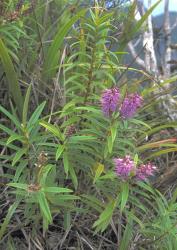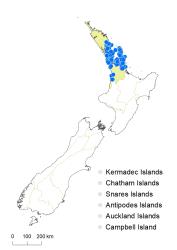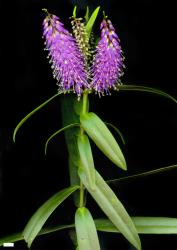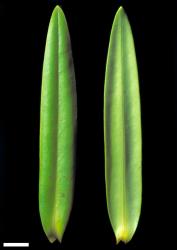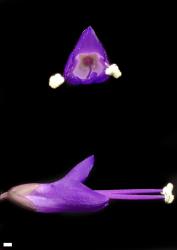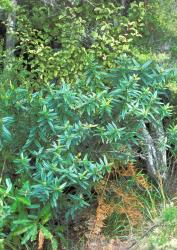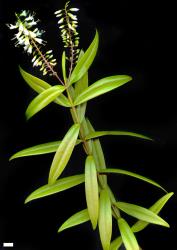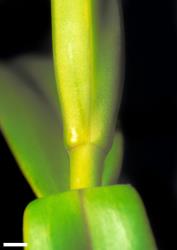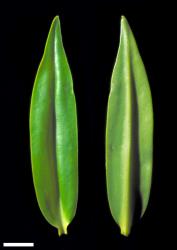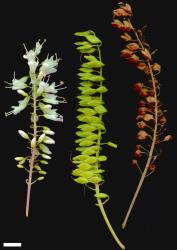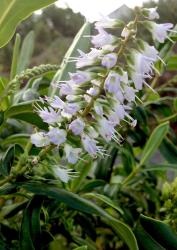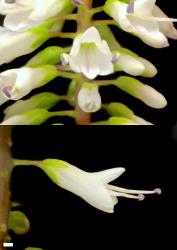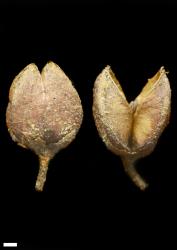- Taxon
- Gallery
- ≡ Panoxis macrocarpa (Vahl.) Raf., Med. Fl. 109 (1830) nom. illeg.
- ≡ Hebe macrocarpa (Vahl) Cockayne & Allan, Trans. New Zealand Inst. 57: 20 (1926)
- = Veronica latisepala Kirk, Trans. New Zealand Inst. 28: 530 (1896)
- ≡ Veronica macrocarpa var. latisepala (Kirk) Cheeseman, Man. New Zealand Fl. 505 (1906)
- ≡ Hebe macrocarpa var. latisepala (Kirk) Cockayne & Allan, Trans. New Zealand Inst. 57: 20 (1926)
Shrub to 3 m tall. Stems erect, eglandular-pubescent; hairs uniform to bifarious. Leaf bud distinct, its leaves appressed at margins until fully grown, sinus absent. Leaves opposite-decussate, erecto-patent to recurved; lamina coriaceous, linear to elliptic to oblong to oblanceolate, 45–110 (rarely 23–163) mm long, 9–22 (rarely 5–32) mm wide, glossy green or dark green above, dull pale green or green beneath; midrib and secondary veins evident; surfaces glabrous except sometimes for eglandular hairs along midrib above; margin glabrous or ciliate, entire, narrowly cartilaginous; apex obtuse to acute or sometimes apiculate or acuminate; base cuneate to truncate; petiole absent or indistinct, 1–2 mm long. Inflorescence a lateral raceme, 30–132 mm long; flowers crowded to distant, 13–85, all bisexual; bracts alternate or sometimes lowermost pair opposite, lanceolate to deltoid to oblong, < pedicels; pedicels spreading to recurved, 1.0–5.5 mm long, puberulent all round. Calyx lobes 4, acute to obtuse, 2–4 mm long, equal, glabrous or rarely hairy outside, mixed glandular- and eglandular-ciliolate. Corolla 5–9 mm diameter; tube white or purplish to pinkish, 2.2–5.5 mm long, > calyx, eglandular-hairy inside; lobes 4, white or purplish, sometimes pinkish, erect to sub-erect, or posterior lobe spreading, unequal, elliptic to ovate, to deltoid and narrowed at base, 3–6 mm long, obtuse; nectar guides absent. Stamen filaments white to pale purplish, 5.5–12.2 mm long; anthers pink, purplish, or yellow. Style glabrous, 5.0–11.5 mm (rarely to 17 mm) long. Capsules latiseptate, acute or sub-acute, glabrous, 3.8–10.0 mm long, 3.0–6.5 mm at widest point. Seeds discoid or broadly ellipsoid, flattened, smooth, pale brown to brown, 1.0–2.5 mm (sometimes to 3.2 mm) long.
adamsii | macrocarpa | perbella | saxicola | |
|---|---|---|---|---|
Stem hairs | uniformly to bifariously puberulent or glabrous | uniformly to bifariously puberulent | glabrous | usually glabrous or rarely bifarious-puberulent |
Leaf bud sinus | present | absent | absent | absent |
Lamina (above) | glossy | glossy | glossy | dull |
Calyx colour | dark green or bronze-green | yellow-green | pink, reddish, violet, or red- to brown-green | yellowish- to dark green |
Calyx lobes outer surface | minute sessile glands | glabrous or eglandular-puberulent | minute sessile glands | minute sessile glands |
Corolla colour | white to mauve, rarely violet | white, rarely lilac, sometimes tinged lilac or pink | violet-red, violet, pink, deep mauve, very rarely carmine | pale lavender (rarely lilac) |
Corolla tube | ≤ calyx; hairy inside | > calyx; hairy inside | ≤ calyx; hairy inside | < calyx; glabrous inside |
Corolla lobes | subacute | obtuse to rounded | acute | subacute or bluntly acute |
Capsule | glabrous | glabrous | glabrous except for a few short hairs along septal grooves | glabrous |
Distribution | far North, known only from four sites, all within 1 km2, west of Spirits Bay | southern Northland from Whangārei and southern Kaipara Harbour southwards to South Auckland, Coromandel, and near Kawhia | western Northland between Ahipara and Waima Forest | known only from Maungaraho Rock, near Dargaville |
North Island: Northland, Auckland (from Whangārei south to Kawhia, Hauraki Gulf islands, Mercury Is.), Volcanic Plateau (southern Kaimai Range).
Scrub, forest margins, open places in forests, rock outcrops and cliffs. Recorded elevations range from 0 to 1275 m.
V. macrocarpa commonly hybridises with V. stricta, a hybrid that has been called V. ×affinis (Cheeseman) Garn.-Jones.
Flowers: April–November (rarely to January); fruits: January–December.
2n = 80, 120 (see Bayly & Kellow 2006, as Hebe macrocarpa).
Veronica macrocarpa is classified in V. subg. Pseudoveronica sect. Hebe and the informal group “Occlusae” (Albach & Meudt 2010; Bayly & Kellow 2006).
The relationships of V. macrocarpa are unclear, but similar flowers and fruits are found in several other northern species, such as V. corriganii, V. punicea, V. adamsii, V. speciosa, and V. perbella. Molecular systematics indicates these species might all belong in a large clade with a number of other species.
This treatment follows the circumscription of this species in Bayly & Kellow 2006; i.e., it includes V. latisepala (V. macrocarpa var. latisepala), and excludes var. brevifolia (Veronica punicea) and V. corriganii.
There is considerable variation within V. macrocarpa. In general, plants from Great Barrier I. (Aotea I.), Te Hauturu-o-Toi / Little Barrier I., and some localities at Whangārei and Coromandel can be distinguished as V. macrocarpa var. latisepala. These have narrower leaves, compact and secund inflorescences of recurved violet flowers that have brownish and often obtuse calyx lobes, and very long corolla tubes, stamen filaments, and styles. These also have 2n = 120. However, some plants with 2n = 120 have white flowers (see Bayly & Kellow 2006 for a fuller discussion of the difficulties of consistently recognising two varieties).
In addition, flower and capsule sizes vary within V. macrocarpa, especially in plants from mainland populations.



